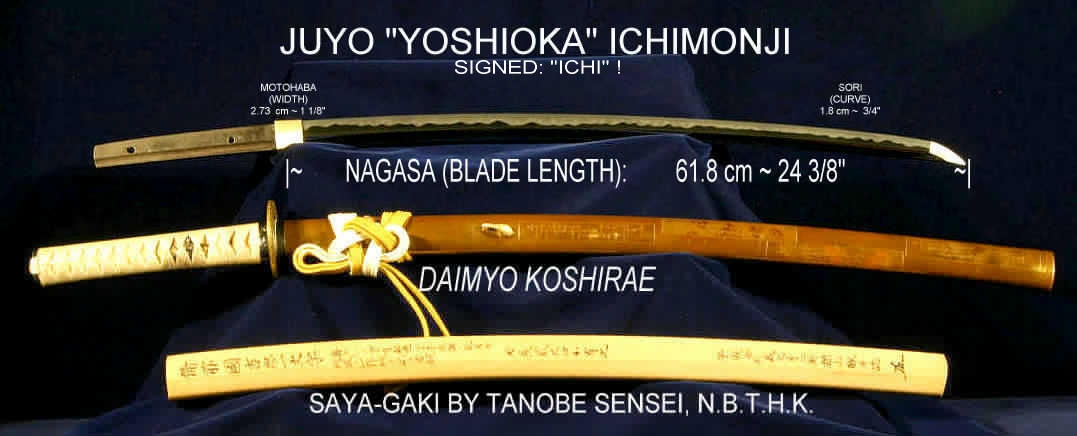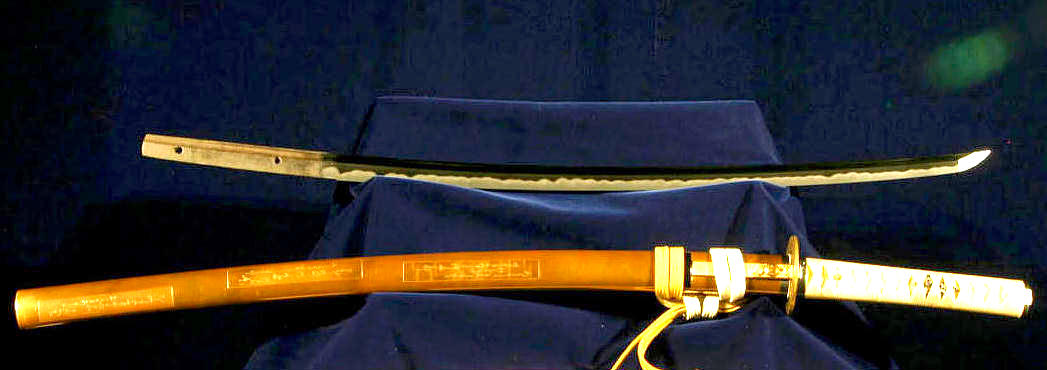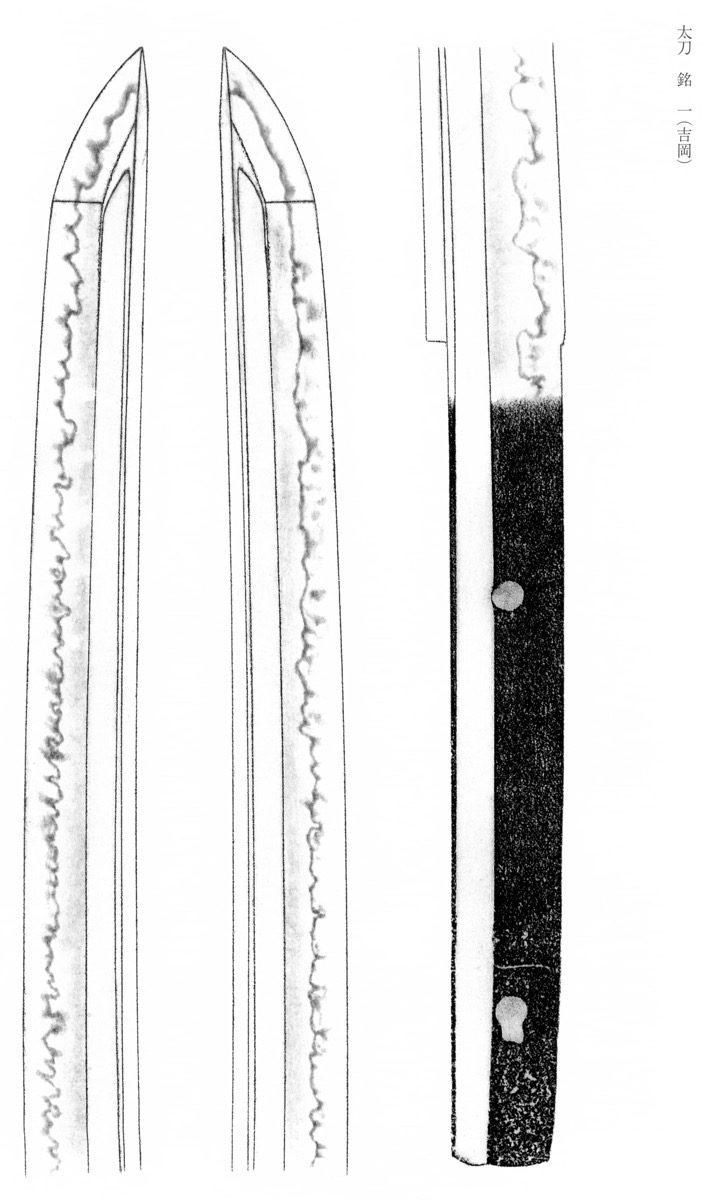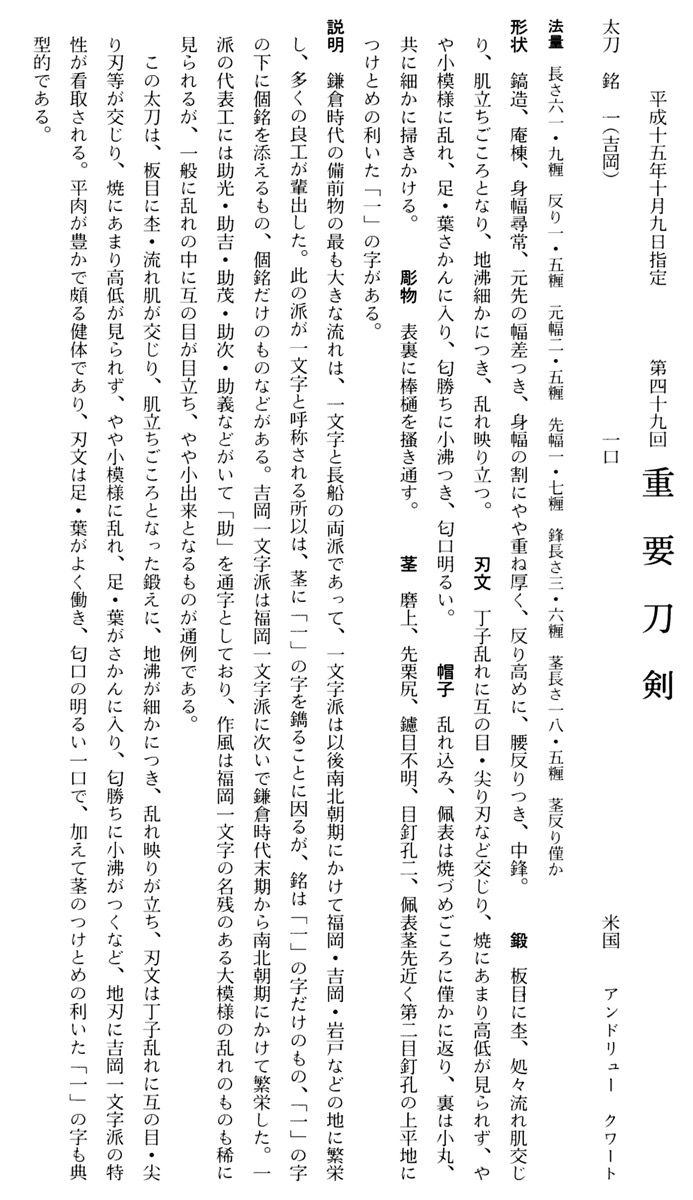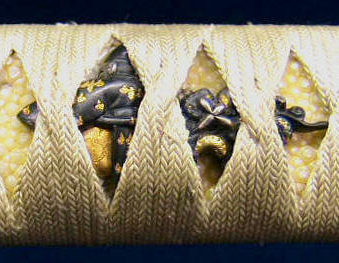Gallery Page (Display Only)
YOSHIOKA ICHIMONJI
CIRCA 1290 AD.
DAIMYO KOSHIRAE
Juyo token by the NBTHK
saya-gaki by TANZAN, Tanobe Michihiro sensei
IT IS A VERY INTERESTING FACT THAT “ICHIMONJI”, THE MOST FAMOUS SCHOOL OF SWORD MAKING DURING THE KAMAKURA PERIOD ( 70 % OF TODAY’S NATIONAL TREASURE SWORDS, ARE FROM THIS PERIOD ), ACTUALLY HAD ITS “GRASS ROOTS BEGINNINGS AT SEA”! HAD THERE NEVER BEEN A BATTLE OF “DEN-NO-URA” IT IS ALMOST CERTAIN THAT THE “ICHIMONJI SCHOOL” WOULD NEVER HAVE BEEN BORN! THE MAJORITY OF “ICHIMONJI” MAKERS WERE FROM BIZEN.
“BIZEN”, IS THE ONLY PROVINCE THAT HAS EXPERIENCED CONTINUOUS SWORD PRODUCTION FROM THE “HEIAN PERIOD”, TO THE “SHIN-SHINTO” PERIOD. THUS EXPERIENCED SWORD SMITHS OF THE HIGH LEVELS, WERE ABUNDANT. THROUGHOUT THE HISTORY OF SWORD MAKING, BIZEN PROVINCE WAS DOMINATE. BIZEN PROVINCE. POSSESSED ALL OF THE NECESSARY ELEMENTS, AND REQUIREMENTS FOR SUCCESSFUL SWORD MAKING. “BIZEN TETSU” ( IRON ) WAS EXCEPTIONAL PURITY, AND OF THE HIGHEST QUALITY. HIGH GRADE SAND IS ALSO AVAILABLE, AS IT IS CLOSE TO THE SEA. THE WATER SUPPLY FROM THE “ASAHI GAWA”, AND “YOSHII GAWA” RIVERS WAS VERY PURE. THE SOIL PRODUCES FINE WOOD, FROM WHICH SOME OF THE “HIGHEST GRADE CHARCOAL” EVER SEEN IS PRODUCED, EVEN TO THIS DAY! THE OTHER SIGNIFICANT FACTOR, IS THE SUPPLY ROUTE, THE “SANYODO HIGHWAY” PASSES DIRECTLY THROUGH BIZEN. IN SUMMARY, THE CONDITIONS IN BIZEN WERE ABSOLUTELY IDEAL, FOR “SWORD MAKING”. “BIZEN”, IS CREDITED WITH THE HIGHEST SWORD PRODUCTION STATISTICS, IN THE HISTORY OF JAPAN. “BIZEN OSAFUNE”, THE CITY OF SWORD SMITH’S. AT ONE TIME “80 %” OF THE RESIDENTS OF “OSAFUNE” WERE SWORD SMITHS. WITH SO MANY SWORD SMITHS LIVING IN CLOSE PROXIMITY, THE SHARING OF ADVANCEMENTS, THOUGHTS, AND TECHNOLOGY WAS RESPONSIBLE FOR A VAST NUMBER OF IMPROVEMENTS, AND INNOVATIONS IN THE ART OF SWORD MAKING. THIS GAVE THE OSAFUNE SCHOOL, A TREMENDOUS ADVANTAGE IN AN AGE OF LESS THAN IDEAL NATIONWIDE COMMUNICATION.
THE YOSHIOKA ICHIMONJI GROUP WORKED FROM 1288 TO THE MID 1300’S WITH THE FOUNDER BEING SUKEYOSHI, WHO WAS THE GRANDSON OF FUKUOKA ICHIMONJI SUKEMUNE KAMAKURA ERA INTO NANBOKUCHO ERA. THEY WERE VERY ACTIVE AND PROGRESSED GROUP AT YOSHIOKA WHICH IS LOCATED AT THE WEST SIDE OF THE YOSHII RIVER IN BIZEN PROVINCE. WITH ICHIMONJI GROUPS, THEY ARE ASSOCIATED WITH THE NAMES OF THE LAND; FUKUOKA, YOSHIOKA, KATAYAMA AND IWADO (OKI).
J?y?-t?ken at the 49th j?y? shinsa held on October 9, 2003
tachi, mei: Ichi (?) (Yoshioka, ??)
USA, Andrew Quirt
Measurements
nagasa 61.9 cm, sori 1.5 cm, motohaba 2.5 cm, sakihaba 1.7 cm, kissaki-nagasa 3.6 cm, nakago-nagasa 18.5 cm, only very little nakago-sori
Description
Keij?: shinogi-zukuri, iori-mune, normal mihaba, noticeable taper, relatively thick kasane in relation to mihaba, deep koshizori, ch?-kissaki
Kitae: rather standing-out itame that is mixed with mokume and some nagare and that features fine ji-nie and a midare-utsuri
Hamon: widely hardened ch?ji-midare in nioi-deki with ko-nie and a bright nioiguchi that does not show many undulations, that is composed of relatively small elements, and that is mixed with gunome, togariba, and plenty of ashi and y?
B?shi: midare-komi, on the haki-omote side with a brief kaeri that tends to yakitsume, on the ura side with a ko-maru-kaeri, both sides feature fine hakikake
Horimono: on both sides a b?hi that runs as kaki-t?shi through the tang
Nakago: suriage, kurijiri, the yasurime are indiscernible, two mekugi-ana, the haki-omote side bears towards the tip of the tang and on the hira-ji above of the second mekugi-ana a sharply chiseled character for “Ichi”
Explanation
The two major currents of Kamakura period sword making in Bizen province were Ichimonji (???) and Osafune (??). The Ichimonji School continue to flourish throughout in the Nanbokuch? period and had distributed over locations like Fukuoka (??), Yoshioka (??), and Iwato (??), giving rise to many great master smiths. The name of the school goes back to the fact that some of its smiths signed with the character for “One” (ichi), or with the character for “One” followed by an individual name below, or just an individual name and without the character for “One.” The Yoshioka-Ichimonji School particularly thrived after the Fukuoka-Ichimonji School had peaked, i.e., from the end of the Kamakura to the Nanbokuch? period. Smiths from this school shared the character for Suke (?) and representative masters were, i.a., Sukemitsu (??), Sukeyoshi (??), Sukeshige (??), Suketsugu (??), and Sukeyoshi (??). Although rarely, the Yoshioka-Ichimonji smiths did hardened in a flamboyant and large dimensioned midareba as their Fukuoka-Ichimonji colleagues did, but their main focus was a midare with a prominent amount of gunome whose elements are rather small dimensioned.
This tachi shows a rather standing-out itame that is mixed with mokume and nagare and that features fine ji-nie and a midare-utsuri. The hamon is a widely hardened ch?ji-midare in nioi-deki with ko-nie that does not show many undulations, that is composed of relatively small elements, and that is mixed with gunome, togariba, and plenty of ashi and y?. Thus, the jiba reflects the characteristic features of the Yoshioka-Ichimonji School. The blade is with its abundanc of hira-niku astonishingly healthy and with the hamon and its plenty of ashi and y?, its bright nioiguchi, and the sharply chiseled character for “Ichi” in the tang, we have here a textbook example for this school.
This Sword is not available for purchase.
If you wish to purchase a Japanese Sword, please view our Nihonto for sale page or contact us directly via email or by telephone at 1(608) 315-0083 any time. Please include specifics of what you seek, i.e.: Katana, maker, era, price range, etc.
Pictures and content may not be copied without the express permission of samuraisword.com ©


